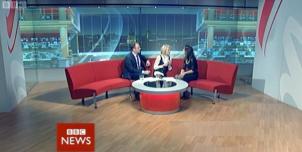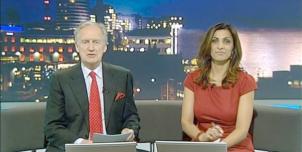Full Freeview on the Waltham (Leicestershire, England) transmitter
| Google Streetview | Google map | Bing map | Google Earth | 52.801,-0.801 or 52°48'4"N 0°48'5"W | LE14 4AJ |
The symbol shows the location of the Waltham (Leicestershire, England) transmitter which serves 770,000 homes. The bright green areas shown where the signal from this transmitter is strong, dark green areas are poorer signals. Those parts shown in yellow may have interference on the same frequency from other masts.
This transmitter has no current reported problems
The BBC and Digital UK report there are no faults or engineering work on the Waltham (Leicestershire, England) transmitter._______
Digital television services are broadcast on a multiplexes (or Mux) where many stations occupy a single broadcast frequency, as shown below.
64QAM 8K 3/4 27.1Mb/s DVB-T MPEG2
DTG-12 QSPK 8K 3/4 8.0Mb/s DVB-T MPEG2
H/V: aerial position (horizontal or vertical)
Which Freeview channels does the Waltham transmitter broadcast?
If you have any kind of Freeview fault, follow this Freeview reset procedure first.Digital television services are broadcast on a multiplexes (or Mux) where many stations occupy a single broadcast frequency, as shown below.
64QAM 8K 3/4 27.1Mb/s DVB-T MPEG2
DTG-12 QSPK 8K 3/4 8.0Mb/s DVB-T MPEG2
H/V: aerial position (horizontal or vertical)
Which BBC and ITV regional news can I watch from the Waltham transmitter?

BBC East Midlands Today 0.9m homes 3.4%
from Nottingham NG2 4UU, 28km northwest (306°)
to BBC East Midlands region - 17 masts.

ITV Central News 0.9m homes 3.4%
from Birmingham B1 2JT, 83km west-southwest (244°)
to ITV Central (East) region - 17 masts.
All of lunch, weekend and 80% evening news is shared with Central (West)
Are there any self-help relays?
| Braunstone | Transposer | 5 km SW Leicester city centre | 170 homes |
How will the Waltham (Leicestershire, England) transmission frequencies change over time?
| 1984-97 | 1997-98 | 1998-2011 | 2011-13 | 2013-18 | 2013-17 | 4 Mar 2020 | |||
| C/D E | E | E | W | W T | W T | W T | |||
| C26 | LNG | LNG | |||||||
| C29 | SDN | SDN | SDN | SDN | |||||
| C31 | com7 | com7 | |||||||
| C32 | BBCA | ||||||||
| C34 | D3+4 | ||||||||
| C35 | C5waves | C5waves | BBCB | ||||||
| C37 | com8 | com8 | |||||||
| C41 | _local | ||||||||
| C49tv_off | BBCA | BBCA | |||||||
| C54tv_off | C4waves | C4waves | C4waves | D3+4 | D3+4 | D3+4 | |||
| C55tv_off | com7tv_off | ||||||||
| C56tv_off | ArqA | ArqA | ArqA | COM8tv_off | |||||
| C57tv_off | ArqB | ArqB | ArqB | ||||||
| C58tv_off | BBC1waves | BBC1waves | BBC1waves | BBCB | BBCB | BBCB | |||
| C61 | ITVwaves | ITVwaves | ITVwaves | BBCA | |||||
| C64 | BBC2waves | BBC2waves | BBC2waves |
tv_off Being removed from Freeview (for 5G use) after November 2020 / June 2022 - more
Table shows multiplexes names see this article;
green background for transmission frequencies
Notes: + and - denote 166kHz offset; aerial group are shown as A B C/D E K W T
waves denotes analogue; digital switchover was 17 Aug 11 and 31 Aug 11.
How do the old analogue and currrent digital signal levels compare?
| Analogue 1-5 | 250kW | |
| BBCA, D3+4, BBCB | (-7dB) 50kW | |
| SDN, ARQA, ARQB | (-10dB) 25kW | |
| com8 | (-12.7dB) 13.4kW | |
| com7 | (-13.9dB) 10.2kW | |
| Mux 1* | (-14dB) 10kW | |
| Mux 2*, Mux A*, Mux B* | (-14.9dB) 8kW | |
| Mux C*, Mux D*, LNG | (-17dB) 5kW |
Local transmitter maps
Waltham Freeview Waltham DAB Waltham AM/FM Waltham TV region BBC East Midlands Central (East micro region)Which companies have run the Channel 3 services in the Waltham transmitter area
|
|
Friday, 27 December 2013
M
Michael11:56 PM
MikeP: I didn't mention Sky in my post. But if there were no digital terrestrial transmissions before DSO, then what was I was watching via my digital box and then IDTV via an aerial before 2008? Unless we're not talking about the same thing...?
| link to this comment |
Saturday, 28 December 2013
MikeP
9:41 PM
9:41 PM
I am talking about the reception of TV services from terrestrial transmitters to be received by the general public. There were NO digital terrestrial transmission for general public reception prior to the switch from analogue to digital broadcasting from around 2008. There were no domestic TV sets capable of such terrestrial reception until much later.
The *only* digital broadcasts available until then were from Sky starting around 1997/8 or previously from British Satellite Broadcasting from around 1992/3 (using the squarial), they were bought out by Sky to gain access to the digital technology and contracts owned then by BSB. These digital services did not catch on well due to various technical problems and costs.
All terrestrial broadcasts of BBC1, BBC2, ITV, Channel 4 and Channel 5 prior to 2008 intended for general public reception were entirely analogue, any digital transmissions, as mentioned by Briantist, were the links between distribution centres and the transmitter sites (these were then always converted back to analogue format for transmission to the general public). There were, therefore, no digital terrestrial transmissions for reception by the general public - and it wasn't just Ch4. The microwave link system was gradually converted to a digital system in preparation for the full digital switchover from 2008.
Michael, I suspect you were watching analogue transmissions on a TV that was possibly capable of both analogue and digital reception - but with no digital signals being available to the general public you would have to have been watching analogue transmissions. Perhaps you can enlighten us with a model number of your 'digital box', the only ones I know of were for satellite reception and not terrestrial.
Several years ago ITT sold a 'digital' TV set, but it was entirely for analogue signal reception, it then converted the signals into digital format internally for processing before conversion back to analogue to drive the CRT and loudspeakers. It did not have any digital reception capability.
| link to this comment |
MikeP
9:47 PM
9:47 PM
One other point. Integrated Digital Televisions (IDTVs) could be connected via a broadband connection and receive programmes via the internet. These would have been in digital format for distribution via the web. However, such receivers could also get analogue terrestrial signals via and aerial and display them. The design could well have 'blurred' the distinction between viewing via the internet and an aerial (of analogue signals). So it could diplay non-broadcast programmes from a digital source, but not received via the aerial.
| link to this comment |
MikeP: What was ONdigital, later to become ITV Digital then?
| link to this comment |
Sunday, 29 December 2013
K
KMJ,Derby12:27 AM
MikeP: Time flies! DTT was on air for 10 years prior to the start of DSO. Regarding satellite, the BSB squarial lasted from 1989 to 1991. as Sky merged with BSB in 1990.
| link to this comment |
M
Michael1:17 AM
MikeP: I've never had a satellite system, and have been watching digital channels from well before 2008 from the Craigkelly transmitter.
The TV was a Bush 26" CRT and was clearly digital - how else do you think that people managed to watch Setanta Sports and all of the other non-analogue channels before 2008?
Even if you don't trust Wikipedia - trust this very website which details the UHF channels for the 6 muxes 1,2,A,B,C,D from 1998 to DSO on each full freeview transmitter page!
| link to this comment |
S
SeeMoreDigital11:47 AM
I've always been interested in receiving television transmissions. Over the years I've installed motorised VHF/UHF aerials and satellite dishes on various houses I've lived in. Much to the amusement of my neighbours.
So yes I bought into the very short lived BSB D-MAC platform, which I purchased a few months before its official launch in March 1990. Which I adapted to D2-MAC to extend its life.
And yes of-course I bought into this countries first Digital Video Broadcast platforms when they were launched by SkyDigital (DVB-S) in Oct 1998 and ONdigital (DVB-T) in Nov 1998.
Indeed, up until a few months ago I still had all my old set-top boxes including receipts in my loft... I can't believe how much I've spent over the years.
So yes DVB-T has been available in this country since November 1998...
| link to this comment |
MikeP
7:34 PM
7:34 PM
NONE of the main transmitters nor the over 1000 relays ever broadcast a digital signal prior to the start of switch over from analogue to digital.
BSB didn't start until 1991, Astra started in 1989 and broadcast the Sky services amongst others. I worked at a senior technical training manager for Radio Rentals at that time and developed all the training materials used for several years for the installation and servicing of satellite systems, both Astra and BSB, soI have considerable experience in this field and I know what I am talking about.
If anybody thinks there were digital transmissions available to the general public from terrestrial transmitters before the official switchover starting in late 2007 but continuing until at least 2011they are sadly misinformed.
Setanta Sports was NOT available in the UK on any terrestrial transmitter prior to switchover. It was available via satellite but not terrestrial.
| link to this comment |
M
mazbar8:22 PM
MikeP: just looked on Wikipedia it states that on digital started in 1998 so that's sadly misinformed is it ?
| link to this comment |
MikeP: Of course they were available but on a quasi-national basis where only main transmitters and larger relays carried them on lower power. This is rather like the new HD muxes, although their coverage is even sparser.
If you're referring to the first transmitter where the analogue was switched off and where the digital was (in real terms) at the same power as the former analogue then this was before 2007.
The Ferryside transmitter was the first to be converted to digital in March 2005, albeit that BBC 2W analogue remained until 2009. So unless residents only wished to view BBC 2W they had to use a digital receiver.
| link to this comment |
Select more comments
Your comment please!





